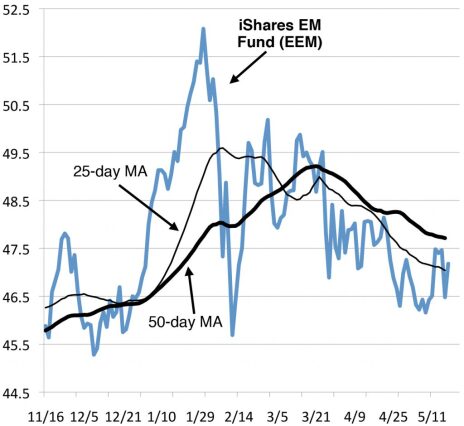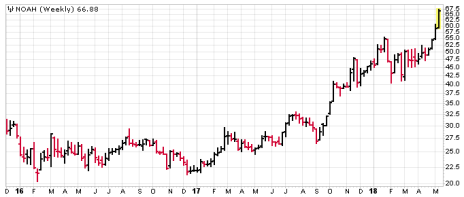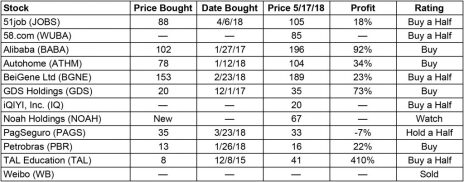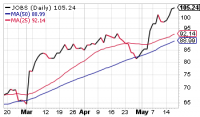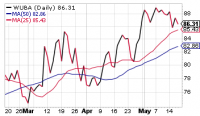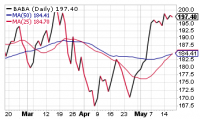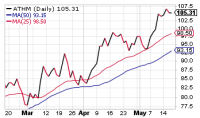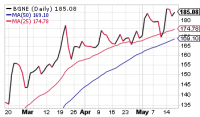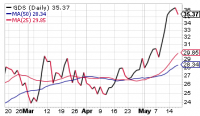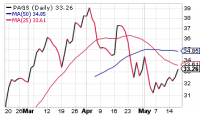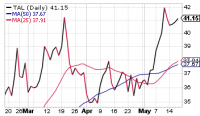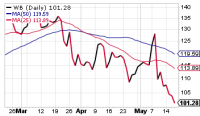While we have yet to get a buy signal from the Cabot Emerging Markets Timer, our stocks are generally performing very well and we have only a couple of quarterly reports yet to come. In today’s issue, I talk about the trouble with too much news and write up a Chinese financial company that has a powerful head of steam up, with only a Q1 report to worry about.
Cabot Emerging Markets Investor 659
[premium_html_toc post_id="150246"]
Cabot Emerging Markets Timer
The Emerging Markets Timer is our disciplined method for staying on the right side of the emerging markets. The Timer is bullish when the index is above the lower of its two moving averages and that moving average is trending up.
Our Emerging Markets Timer is still in negative territory, though we’re encouraged to see strength among a rash of Chinese stocks. First, when looking at the iShares EM Fund (EEM), it just hasn’t been able to get out of its own way; its action today dropped it back below its moving averages, which keeps the intermediate-term trend pointed down.
Better news comes from the Golden Dragon Fund (symbol PGJ), which has entered a new intermediate-term uptrend, and from many individual stocks, which are acting well. All told, we’re cautiously optimistic and continue to take things on a stock-by-stock basis, holding your strong performers and looking for opportunistic new buys.
Too Much News
Investing isn’t easy. No activity that must reduce thousands of pieces of data to a single decision—buy or sell—can be easy. When you think about the legions of researchers and analysts at big investment firms, it should be obvious that having too much information is virtually useless in the pursuit of buying great growth stocks.
The only strategy that stands a chance in hell of succeeding is to reduce your inputs to a manageable level, then custom build a simple set of rules that will allow you to make profitable decisions consistently.
That’s what the Cabot team of growth analysts has done over the decades. And at the risk of throwing them at you one time too many, here’s what the rules say:
1. Let winners run. 2. Cut losses short. 3. Stay in step with the market.
That’s it. You can embroider them onto a pillow or have them tattooed onto your thigh. What you can’t do is ignore them, because if you do, the market will be happy to treat you like a frog on the freeway.
That said, I have one other observation to make about how markets are acting recently. That is that it’s especially difficult to do growth investing in a news-driven market.
We have made our peace with the four earnings seasons per year that have the potential to trip up any stock that doesn’t meet analysts’ consensus estimates for revenue, earnings and guidance. We sold Weibo (WB) in a Special Bulletin on Tuesday evening after the company failed to outperform estimates in a sufficiently spectacular way.
Weibo will probably be fine in the long run, but in this kind of wobbly market, I have no appetite for violating Rule 2 (see above). I’ve done it a few times in my career at Cabot, and the scars mostly don’t show. But it’s a lesson that the market is always happy to reinforce.
The news that I’m complaining about is the stream of unpredictable decisions flowing from Washington, D.C. and the global repercussions that spring from them.
Specifically, it would be good for investors in China to know whether the U.S. and China are cooperating to keep protective tariffs at a minimum or ramping up a trade war. It would also be good if the future of the relationship between the U.S. and Europe were clearer and we had a better idea of how much Middle Eastern oil will be flowing into the U.S. And North Korea remains the wildest of wild cards.
Investors, especially the institutional whales who need as clear a picture as possible of the future of the U.S. economy, the global economy and the relations among the countries and markets of the world, are skilled at turning news into market bets. That’s what we mean when we say that a piece of information has been “priced into” the market.
But too much news can wear on investors. It’s easier for them to digest a big piece of news (like Brexit) than it is to recalculate their economic estimates every week because of policy changes. When significant changes happen too often, fatigue sets in, with its accompanying reactiveness, nervousness and volatility.
The bottom line is, of course, that we have to invest in the market we have, not the market we wish we had. That’s what Rule 3 reminds me every day.
Featured Stock
Follow the Money
Noah Holdings (NOAH)
The wealth that has been created by China’s economic prosperity has created a massive demand for investment opportunities. There aren’t as many ways to put money to work in China as there are in the U.S., and pressure for returns has fueled a persistent real-estate bubble as investors see housing and other properties as a relatively low-risk way to achieve some alpha.
Noah Holdings, incorporated in 2005, is an investment firm that offers other alternatives. Noah offers fixed-income, private equity and securities investments to both high-net-worth individuals and enterprises through its 237 branches and sub-branches in 79 Chinese cities. The company’s offices are concentrated in the Shanghai, Beijing and Hong Kong metropolitan areas, but services are also offered in Taiwan, Australia and the U.S.
As of its latest earnings report, Noah had about 187,000 registered clients and nearly $23 billion in assets under management. Actual management services are offered through Gopher Asset Management, a wholly owned subsidiary.
Noah’s revenue growth slowed from 37% in 2015 to 11% in 2016 and 12% in 2017, but earnings growth has remained robust, accelerating throughout 2017 from 4% in Q1 to 45% in Q4. After-tax profit margins have consistently topped 20%. And analysts expect earnings growth to pick up to 22% this year and 23% in 2019.
The recent appreciation in NOAH is both an attraction and a caution. The stock was trading at 48 on April 19 and had made zero net progress since November 2017 despite advances to as high as 56 in late January and dips to as low as 40 in February.
But NOAH caught fire in late April, and has soared to near 67 in recent trading.
This kind of advance is great evidence that institutional investors (there are 115 now compared to 62 a year ago) are piling into the stock.
But it also means that the stock has left its rising 25-day moving average behind at 54 and increased its P/E ratio to 30.
And when you add to the equation that Noah Holdings will announce its Q1 earnings less than two weeks from today (on May 29, after the market closes, with a conference call at 8:00 pm EST), there is no clear buy signal.
Still, there are few substitutes in growth investing for momentum. A rising chart is the best evidence there is that investors are changing their minds about a stock. And with a five-month base to build on, NOAH should have plenty of fuel in its tank—if earnings are well received.
As a final note, we regard NOAH as an old friend, having had the stock in the portfolio back in 2015. We got shaken out as NOAH began a consolidation that featured 27 months of trading in a tightening range with support in the low 20s and resistance at 30.
With earnings coming so soon and the Cabot Emerging Markets Timer sitting on the fence, we will put NOAH on the watch list for now. If you like the story and decide you want to jump the starting gun, you can take a nibble here and see what the reaction is on May 29. There are no analysts’ estimates to worry about, but, as always, the reaction from investors is more important than the numbers. WATCH.
Noah Holdings Limited (NOAH)
Building 2
Changyang Valley No. 1687 Changyang Road
Shanghai 200090
China
86 21 8035 9221
www.noahwm.com
Model Portfolio
Invested 70% Cash 30%
Updates
The environment for emerging market stocks has definitely improved during the past couple of weeks, but we’re not yet seeing clear green lights, either—while the Golden Dragon Fund (PGJ), which tracks U.S.-traded Chinese stocks, has flipped to bullish, our Emerging Markets Timer is still stuck in the red. Thus, we’re optimistic, but are still holding some cash and keeping some stocks on tight leashes.
Tonight, we’re buying half positions in 58.com (WUBA) and IQIYI (IQ), but earlier this week, we sold out of our remaining shares of Weibo (WB).
51Job (JOBS) continues to bask in the glow of its earnings report, which catapulted the stock off its 50-day line and into new-high ground. With the 25-day line down at 92 or so, JOBS is extended, but the upside volume has been outstanding since earnings, so we’re not looking for a giant retreat. We’ll keep our Buy A Half rating, preferably on dips toward 100. BUY A HALF.
58.com (WUBA) hit new highs in late April, just as the market was getting going, though it’s pulled back a bit since. WUBA’s overall chart looks sound to us, and volume on this recent dip was modest. We’re going to buy a half position tonight and, if the stock powers ahead, look to fill out our position north of 90. BUY A HALF.
Alibaba (BABA) has hit a wall during the past few days around 200, which isn’t unusual considering its recent run and the resistance at that level back in January and March. We’re still betting the stock’s multi-month rest is coming to an end, though, so we’ll stay on Buy. Fundamentally, the company’s partially owned payment arm Ant Financial is raising another huge chunk of money, with a total company valuation of $150 billion—and Alibaba owns around one-third of Ant! BUY.
Autohome (ATHM) has been jumpy since breaking out to new highs on earnings last week, but so far, it hasn’t given up much of its gains, a sign of strength. Analysts see earnings up 25% this year and another 23% next. If you don’t own any, you can grab some around here with a stop just below the 50-day line, which is currently above 93 and rising steadily. BUY.
BeiGene (BGNE) remains in an uptrend, though it’s been more volatile of late even as Chinese stocks have improved. The company just began a Phase III trial for a potential maintenance treatment for ovarian cancer. If shares tighten up a bit we could fill out our position, but BGNE’s recent wiggles keep us from doing that now. If you don’t own any, though, feel free to pick up a half position. BUY A HALF.
GDS Holdings (GDS) is another Chinese stock that broke out of a nice-looking base on earnings and has mostly held those gains since, which is a plus. We continue to enthuse about this story, as it’s nearly a sure thing that demand for GDS’ data centers and colocation offerings will boom as e-commerce and cloud computing use in Asia skyrockets. Indeed, in the most recent quarter, GDS began two new projects in Beijing, another in Shanghai and a recent acquisition will eventually lead to a doubling of its capacity in Guangzhou. You can grab shares here. BUY.
iQIYI (IQ) is about as volatile a stock as you’ll see, with 15% to 20% swings every few days not uncommon since the stock came public at the start of April. Still, we like the overall pattern, with IQ blasting to new highs last week and pulling back normally during the past few days. Fundamentally, of course, the current growth (revenues growing at 63% each of the past two quarters) and potential future growth (as advertising and membership revenues boom for its video offerings) are outstanding. We’re buying a half position tonight on the recent dip. BUY A HALF.
PagSeguro (PAGS) is meandering in the low 30s ahead of earnings, which are due out May 29. A break of its recent lows will have us cutting bait, but we’re willing to give this recent IPO a chance to find its sea legs—a positive reaction to earnings could kick-start a new advance. If you own a half position, we advise holding on here. HOLD A HALF.
Petrobras (PBR) staged a picture-perfect breakout last week, with giant volume for two days as the stock ramped, and shares have trickled a bit higher since. We filled out our position last week (buying a second half position) and think there’s excellent potential here, both from the company’s turnaround (and divestiture) program and from the general bull move in energy stocks. BUY.
TAL Education (TAL) continues to hold near its highs, and that’s enough for us to switch back to a Buy A Half rating—if you’re not yet in, you can start with a half-sized position here. Investors are putting more emphasis on the company’s rapid buildout of its business (revenues have risen 59% or more for six straight quarters) and focusing less on earnings (which are only expected to rise 12% this year due to heavy spending). A bit more strength from TAL and the market could have us buying another half on top of what we own. BUY A HALF.
Weibo (WB) looked like it was coming to life, but the firm’s earnings report cracked the stock. While the headline numbers were fine (sales up 76% and earnings up 92%), the outlook was “only” in line, and that was enough to bring out the sellers—WB dove below its long-term 200-day line and kept falling all the way to the century mark. The stock could bounce from here, but the bigger picture is that WB had a monster, monster run from 2016 through early 2018, and now it appears it’s no longer a leader. We sold our half position earlier this week. SELL.
[premium_html_footer]
Send questions or comments to paul@cabotwealth.com.
Cabot Emerging Markets Investor • 176 North Street, Salem, MA 01970 • www.cabotwealth.com
All Cabot Emerging Markets Investor buy and sell recommendations are made in issues or updates and posted on the Cabot subscribers’ website. Sell recommendations may also be sent to subscribers as special alerts via email. To calculate the performance of the hypothetical portfolio, Cabot “buys” and “sells” at the midpoint of the high and low prices of the stock on the day following the recommendation. Cabot’s policy is to sell any stock that shows a loss of 20% in a bull market (15% in a bear market) from our original buy price, calculated using the current closing (not intra-day) price. Subscribers should apply loss limits based on their own personal purchase prices.
THE NEXT CABOT EMERGING MARKETS INVESTOR ISSUE IS SCHEDULED FOR May 31, 2018
We appreciate your feedback on this issue. Follow the link below to complete our subscriber satisfaction survey: Go to: www.surveymonkey.com/chinasurvey
Cabot Emerging Markets Investor is published by Cabot Wealth Network, an independent publisher of investment advice since 1970. Neither Cabot Wealth Network, nor our employees, are compensated in any way by the companies whose stocks we recommend. Sources of information are believed to be reliable, but they are in no way guaranteed to be complete or without error. Recommendations, opinions or suggestions are given with the understanding that subscribers acting on information assume all risks involved. © Cabot Wealth Network 2018. Copying and/or electronic transmission of this report is a violation of the copyright law. For the protection of our subscribers, if copyright laws are violated, the subscription will be terminated. To subscribe or for information on our privacy policy, visit www.cabotwealth.com, write to support@cabotwealth.com or call 978-745-5532.
[/premium_html_footer]


